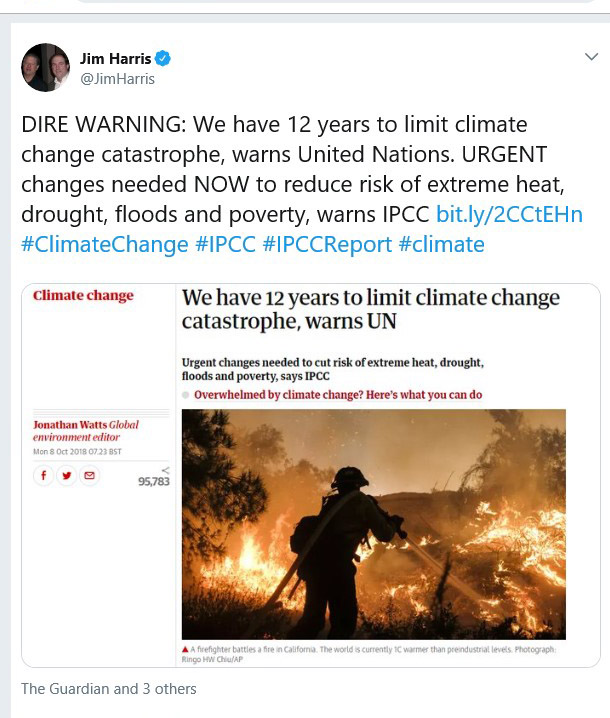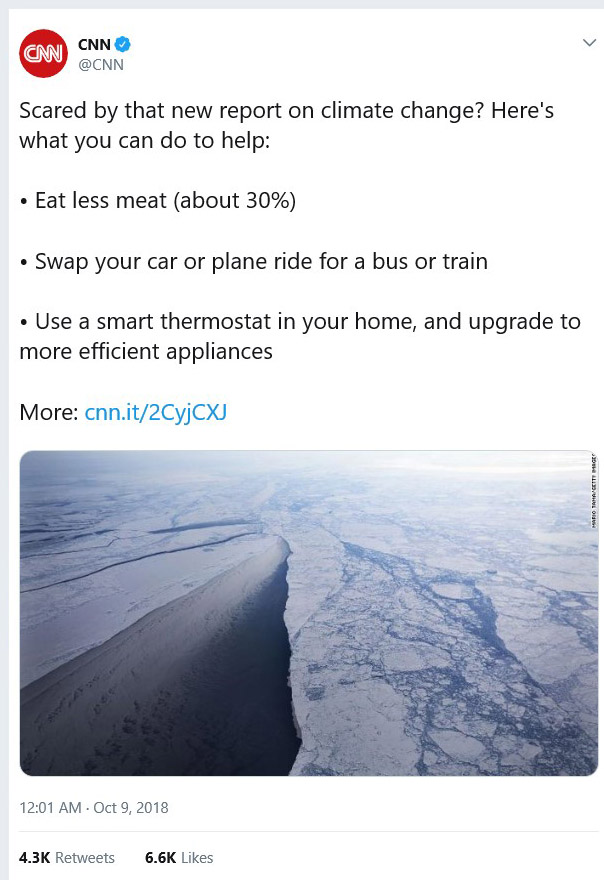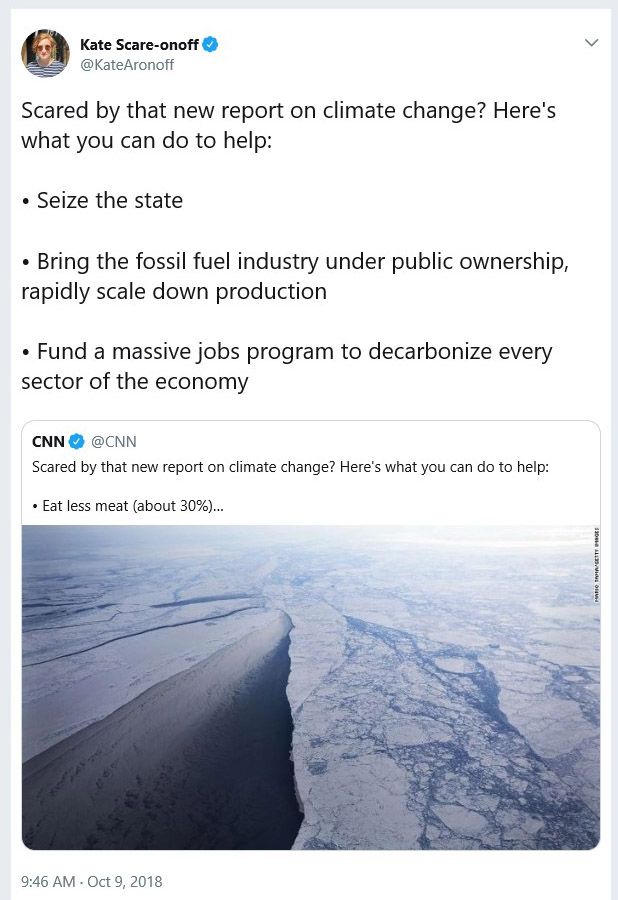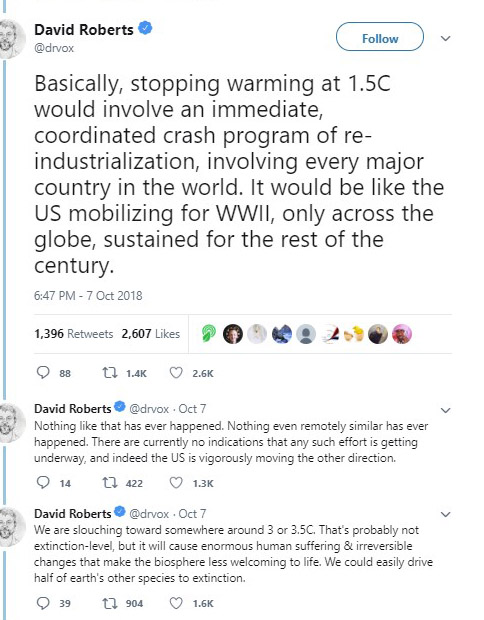To the Teacher:
Consider combining this lesson with our concurrent lesson about the lawsuit young people have brought against the government: Young People's Suit Over Climate Disruption Comes to Court.
Opening
Project this tweet: https://twitter.com/JimHarris/status/1050367848185380864

Ask students if they have heard about the report on climate change by the UN’s International Panel on Climate Change (IPCC) issued in October 2018. The IPCC is the world's leading scientific authority on climate change.
Explain that according to the report, we must cut global carbon emissions in half in 12 years (by 2030), or we will be on track to experience two degrees Celsius of global warming as soon as 2040. Two degrees Celsius is the equivalent of 3.6 degrees Fahrenheit. (To convert from Celsius to Fahrenheit, multiply by 1.8 and add 32.)
For context, you may wish to explain that the planet is already 1 degree C warmer than it was before the Industrial Revolution. The IPCC argues that allowing the planet to warm to 2 degrees will be much worse than if we can limit it to 1.5 degrees.
Effects of 2 Degrees Celsius
Ask students:
- What will happen if the planet warms 2 degrees Celsius or more, on average?
Student responses may include melting of the ice caps, sea level rise, increase in extreme weather events such as droughts, heat waves, and flooding, death of coral reefs, and other ecosystems, and so on.
Project the statistics below on the board or provide them in a handout (CarbonBrief.org). Ask students to read each one aloud.
- At 2 degrees of warming, global GDP will drop by 13 percent. (GDP is the gross domestic product, the amount we collectively produce.) By comparison, the Great Recession of 2007 involved a 4 percent drop in GDP. Global costs of climate damage will be $54 trillion by 2040.
- At 2 degrees of warming, corn crops worldwide will decrease by nine percent, leading to famines.
- At 2 degrees of warming, 400 million more people will suffer from droughts and water scarcity.
- At 2 degrees of warming, heat waves will increase across the world, killing thousands of people in America each summer and many more in tropical countries. India would have 32 times as many extreme heat waves. By 2080, levels of heat and humidity that are deadly for anyone caught outside will occur at least once per decade in many parts of the world (New York Times).
- At 2 degrees of warming, diseases including malaria and dengue fever will strike many more people.
- At 2 degrees of warming, nearly all coral reefs will die, harming the food supply and tourism economy for 500 million people.
- At 2 degrees of warming, sea levels in Miami, Boston, and New York will rise six feet by the end of the century, permanently drowning large areas of these cities. Flood damage costs will be over $11 trillion every year. (If your students live near one of these coastal cities, take a moment to project this map, search for your city, and invite students to notice what parts of your city are underwater: https://xs.climatecentral.org/#12/40.7298/-74.0070?scenario=extreme_p50 )
Discuss as a class, in a circle with a talking piece, or in small groups:
- How might these changes affect your future? Your children’s futures?
- How might worldwide societies react to these changes?
- How might changes in GDP affect lifestyles in the U.S.?
- How might the Middle East react to water scarcity and heat waves?
- How might Central America react to heat waves and increased food prices?
- How might the U.S. react to increased immigration from tropical areas?
Worst-case Scenarios
Explain that the IPCC report is actually relatively optimistic, and the long-term effects of warming will only increase as we emit more carbon into the atmosphere. Explain that the last time that our planet was 2 degrees warmer, in the Pliocene era, sea levels were about 60 feet higher than they are now. (GlobalChange.gov)
Project this image to demonstrate what 60 feet of sea level rise would look like in New York City:
Discuss:
- How would this kind of sea level rise affect New York City? Who would be most affected? Why?
- How might this kind of damage to coastal cities affect the United States as a whole? The housing market? The economy? Jobs?
- What changes would we have to make as a society if the sea level rises 60 feet?
(If students are interested in further exploring future possibilities for New York City, invite them to read the novel New York 2140 by Kim Stanley Robinson, or this review of the book.)
What is Stopping Us from Taking Action?
Remind students that according to the IPCC report, we must cut global carbon emissions in half by 2030 in order to prevent warming to 2 degrees. What would be necessary for this to happen? Here are some ideas people have shared:
Project this tweet and ask a student to read it:
https://twitter.com/CNN/status/1049510036588900352

Then project this second tweet and ask another student to read it:
https://twitter.com/KateAronoff/status/1049657280873009152

Discuss:
- What is the first tweet advocating?
- What is the second tweet advocating?
- What kind of strategy do you think it will take to meet the goal of cutting carbon emissions in half within 12 years?
- What are possible obstacles might we face in implementing such strategies? Consider obstacles that are societal and systemic as well as personal and emotional.
Share with students that some young people are pursuing a legal strategy to address climate change. Their case, known as Juliana v. U.S., will be heard in federal court in Oregon starting on October 29, 2018. The young plaintiffs argue that the U.S. government, in failing to take serious action to stop climate disruption, has failed to protect the public trust for current and future generations. (For more, see our lesson on this suit.)
Project this tweet and ask a student to read it:
https://twitter.com/drvox/status/1049114118270197760
(You may wish to read the author’s next two tweets in the thread as well.)

Inform students that in today’s money, the Allies spent $97 trillion on mobilizing for World War 2, and the U.S. nearly doubled its GDP in seven years (from 1938 to 1945). (source)
Discuss:
- What motivation did the U.S. have to mobilize for World War 2?
- How much do you think this effort affected ordinary people’s lives?
- What do you know about the level of government commitment to this effort?
- How much do you think people were willing to sacrifice (financially, emotionally, personally) to mobilize for their country in this way?
- Do you think people are motivated to make these same sacrifices to prevent climate disaster?
- Since scientists have known about the dangers of global warming since at least the 1960s, why do you think we have not taken mass global action away from fossil fuels already?
Read aloud this excerpt from this essay by Samuel Miller McDonald:
“In order to address this crisis, it is simply necessary that we love other people more selflessly than we do now. That, above all, is what confronting climate disruption demands. Parents often love their children selflessly, sure. But that’s not enough: they have to learn to love other children just as heartily. As climate refugees flee their homes, we’ll have to take strangers into ours. We’ll have to willingly spend tons of public money—that is, our own money—to experiment on technology that may fail, on projects that may weaken our country’s strategic position in the world, on funding projects with benefits we may never see. We have to do the uneconomical thing, take less to give someone else more, pay more for electricity, or pool our resources to buy solar panels. We have to want a future for someone we’ve never met on the opposite side of the world.”
Discuss:
- Why does Samuel Miller McDonald think that love is necessary for fighting climate change?
- Why do we need to love our own children to fight climate change?
- Why do we need to love other people’s children?
- Which sacrifices are hardest for you yourself to make?
- How can we love others in this way?
- How can we help others recognize the importance of loving others in this way?
If time permits, continue reading from the essay:
“In all the superhero and spy movies, somehow the world always finds itself about to be destroyed. To save the world from destruction, the heroes must do some acrobatics, punch some bad guys, and look really cool. Sometimes they make a sacrifice or two. Well, the real end of the world is now staring at us in the face. It’s real. And no superhero is going to fly down and take care of it for us. Every one of us has to be heroic, and real heroics demand far more than what movies tell us they demand. Meeting this challenge will require an almost inhumanly selfless generosity and courage. That’s just the nature and the scale of the problem.”
Discuss:
- What kind of superhero powers do you have?
- How might you begin to use your powers to fight climate change?
Closing
In a go-round, invite students to share what kind of support they personally need in order to face and fight the climate crisis, and one thing they themselves can do to support others.